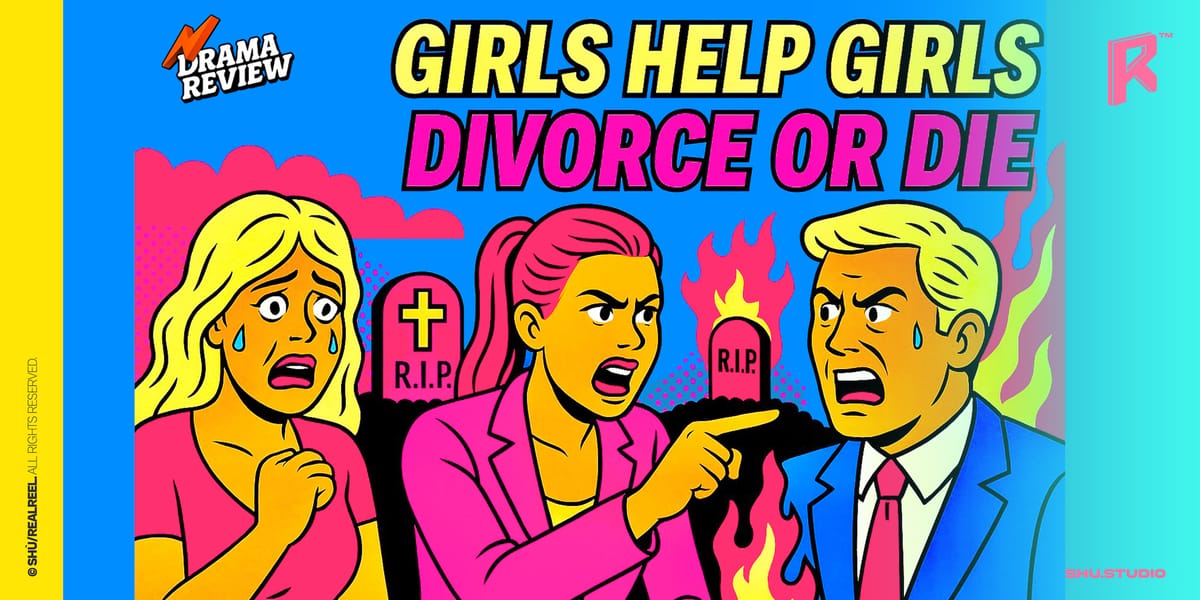Vertical Drama Review: Girls Help Girls: Divorce or Die

⚈ ⚈
It’s fresh, it’s muscular, it’s the opposite of the “naïve good girl” template. You feel the show planting a flag.
Red Flags, Patriarchs & Payback
Join Real Reel(Heads-up: this review contains mild spoilers, consider before reading.)
Caroline Smith doesn’t play the victim, she prosecutes the pattern. A hyper-competent “abuse intervention” pro gets swept into a too-neat blind date with Richard, a silver-tongued divorce attorney who sells therapy-speak and safety. The courtship is fast, the marriage faster and then the mask drops. The opening stretch is razor-cut: a clean chain of action beats, crisp blocking, and a heroine who asserts her rights instead of waiting for rescue. It’s fresh, it’s muscular, it’s the opposite of the “naïve good girl” template. You feel the show planting a flag.
And then…the logic engine coughs.

What Makes It Addictive
The first act is a scroll-stopper: efficient character tagging, a female lead whose competence is shown (not lectured), and fight choreography that feels designed for vertical viewing. NetShort’s favorite triangle: secret identity / independent woman / scumbag-punishing, clicks like clockwork. Micro-arcs close quickly, stakes escalate cleanly, and the show knows exactly when to drop a reversal. If you came for catharsis, the early episodes deliver.
…And Where the Logic Faceplants
- Wedding Night Whiplash. Day one at the husband’s home explodes into a group-abuse tableau: Richard’s father publicly “disciplines” Richard’s mother. The staging is shocking, but the why is cloudy. What power is being asserted, to what end, and why here, now? The patriarchal flex reads loud, not legible.
- Blame the Child? In a later blow-up, a young girl is jostled, faints, heads to the hospital — and the adults decide it’s “because of her.” She even accepts the blame. The psychology is undercooked; the scene feels engineered for outrage rather than truth.
- Consequence Vacuum. Caroline routinely takes down wealthy, connected abusers. Great premise, but where are the counterpunches? No legal heat? No social retaliation? If her targets have money and status, the aftermath should complicate her wins.
- Comedy Where You Don’t Want It. The father swallows a pill and instantly does the “I’m-choking” pantomime. Almost everyone ignores him, except poor Ted, so the bit lands as accidental slapstick.
- Tone Tornado. One minute you’re worrying whether Ted will keel over; the next, the daughter is shoved and falls; seconds later, a previously pummeled creep materializes for a run-in. It’s not momentum — it’s mechanical escalation that flattens emotion.

The Courtroom Problem
Richard supposedly doesn’t know Caroline will appear, yet he unveils a neatly edited “gotcha” video the moment she does, and the hearing devolves into a logic-free circus. Courtroom scenes can bend reality for effect, but they still need internal rules. This one snaps the rubber band.
Why This Still Matters
The series is trying something new: a female-forward revenge spine with a deeper theme — agency rather than endurance. The intent is strong, the form is evolving, and the platform’s willingness to push beyond candy-colored romance deserves credit. With one more week in the writers’ room, tightening motivations, stitching cause-and-effect, and charting believable consequences, this could’ve been a banner title for the format.
For the Short-Drama Nerds (Craft Notes)
- Open with legible sin. The show’s best stretch makes the red flags visible fast, lifting the payoff ceiling.
- Action > speech. Early episodes nail this, let behavior carry theme. Keep that rule as the canvas widens.
- Chart retaliation. If your heroine hits the powerful, map the blowback — legal, social, familial — or the world stops feeling real.
- One escalation at a time. Stack beats for accumulation, not whiplash.
- Courtrooms need rules. Even melodrama obeys physics; legal set-pieces can’t run on coincidence.

Bottom Line
Girls Help Girls: Divorce or Die fires out of the gate with a fresh angle, a strong lead, and punchy, well-cut action. Then it sprays narrative buckshot. Applause for the platform’s genre ambition; frustration at the script’s cause-and-effect shortcuts. Give the team another revision pass, and this one could shine as more than a catharsis machine, it could feel true.
★★★½☆






